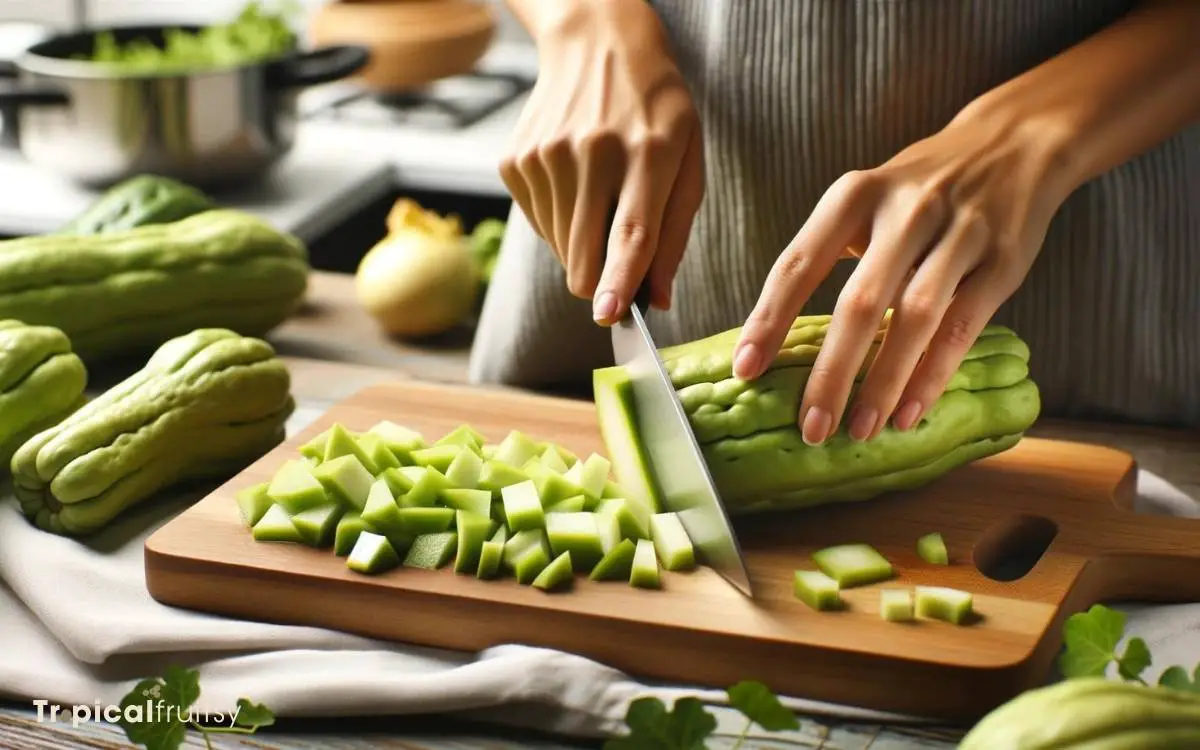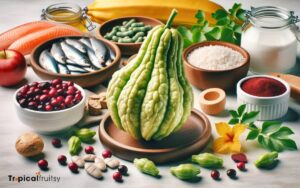How to Cut Chayote for Tinola? 8 Easy Steps!
To cut chayote for tinola, start by washing the skin thoroughly. Slice the chayote in half lengthwise, and remove the seed if desired.
Cut each half into bite-sized wedges or cubes, ensuring they are uniform for even cooking. Peel the skin if preferred, though it’s edible and can be left on.
Tinola is a Filipino soup dish that commonly includes chayote (sayote) as one of its vegetable ingredients.
When preparing chayote for Tinola:
For example, if making tinola for four servings, you might use one or two chayotes, depending on their size and the proportions of other ingredients.
Adding uniformly cut chayote to your tinola ensures every spoonful is filled with the perfect blend of flavors and textures for a comforting and nutritious meal.

Key Takeaway
Step 1: Selecting the Perfect Chayote
We’ll need a firm, unblemished chayote for our tinola to ensure the best texture and flavor. As seasoned cooks, we’ve learned that the quality of ingredients is paramount.
Look for a chayote that feels heavy for its size, a sign of freshness and juiciness. The skin should be bright green without any brown spots or signs of withering.
A ripe chayote should be firm to the touch, yet yield slightly under gentle pressure, similar to a ripe pear.
Avoid those that are too soft as they’re past their prime and won’t hold up well in the soup. Trust us, choosing the right chayote makes all the difference in achieving that authentic, home-cooked taste in your tinola.
Step 2: Washing and Preparing Chayote
Having selected our chayote, let’s wash it thoroughly under cold running water to remove any dirt or potential residue. Proper preparation is vital to ensure our Tinola not only tastes great but is also safe to eat.
Here’s how we do it:
- Inspect the Chayote: Look for any blemishes or soft spots that need to be trimmed off.
- Use a Brush: If available, gently scrub the chayote with a vegetable brush to loosen any stubborn dirt.
- Rinse Well: Make sure to rinse all sides of the chayote, paying extra attention to crevices where dirt may hide.
- Pat Dry: Before proceeding to cut, pat the chayote dry with a clean towel to prevent slipping and ensure a safe cutting experience.
Step 3: Safe Cutting Techniques
We understand that safety is paramount when handling knives, so let’s ensure we’re equipped with the right tools and techniques.
First, we’ll select the appropriate knife for slicing chayote, considering its sharpness and size for precision cutting.
Then, we’ll cover how to grip the chayote securely and guide the knife safely to avoid any mishaps in the kitchen.
Knife Selection
For safe cutting techniques, let’s choose a sharp, sturdy chef’s knife to prepare the chayote for tinola. A dull knife can slip and increase the risk of cutting ourselves, while a sharp one will glide through the chayote with ease and precision.
Here are four key points to remember:
- Select a Chef’s Knife: Ideal for its versatile blade size, usually 8-10 inches.
- Check Sharpness: A sharper knife is safer, requiring less force.
- Firm Grip: Ensure the handle is comfortable, providing control and reducing slippage.
- Blade Maintenance: Regularly hone and sharpen the blade to keep it in optimal condition.
Grip and Stability
Let’s focus on the proper way to hold the chayote and the knife to ensure stability and prevent accidents while cutting.
We’ll employ the ‘claw grip’ for the chayote—tucking our fingertips inwards like a claw, resting the flat side down, to keep it from slipping.
As for the knife, we’ll grasp the handle with our dominant hand, positioning our thumb and forefinger on the sides of the blade near the handle for maximum control—this is called the ‘pinch grip.’
It’s vital we cut with confidence and precision. Ensure the cutting board is non-slip; if necessary, place a damp cloth underneath. Always cut away from your body, using smooth, steady motions.
Cut Direction Safety
In cutting chayote for Tinola, we’ll ensure our safety by always slicing towards the cutting board, never towards our hands or body. This practice minimizes the risk of accidental cuts.
To maintain a safe kitchen environment, here are our top recommendations:
- Use a Sharp Knife: A dull knife can slip and cause injuries. Sharper blades make cleaner cuts.
- Stabilize the Chayote: Grip it firmly on the cutting board to prevent it from rolling.
- Cut from the Top Down: Position the knife at the top of the chayote and slice downwards in one smooth motion.
- Keep Fingers Tucked Away: Curl your fingers under and use your knuckles as a guide for the knife, keeping fingertips out of harm’s way.
Step 4: Peeling the Chayote Skin
Before we tackle the heart of chayote preparation, it’s crucial to address the importance of peeling its skin properly.
We’ll guide you through selecting the right knife and employing safety techniques to ensure a smooth and hazard-free experience.
Knife Selection
When preparing chayote for tinola, we’ll need a sharp, non-serrated knife to effectively peel the tough skin. Choosing the right knife is crucial to ensure safety and ease during the peeling process.
Here’s what we recommend:
- Chef’s Knife: A well-balanced chef’s knife provides control and precision.
- Paring Knife: For finer peeling, a small paring knife can maneuver around curves.
- Utility Knife: This is a versatile option, ideal for both peeling and slicing.
- Vegetable Peeler: While not a knife, a sturdy vegetable peeler can also do the job quickly.
Using the right tool not only speeds up the preparation but also minimizes wastage. We prefer a knife over a peeler for its versatility in handling the subsequent slicing and dicing for the tinola.
Safety Techniques
We’ll ensure our safety while peeling the chayote skin by adopting certain protective techniques. It’s crucial to have a firm grip on both the chayote and the peeler.
We prefer to use a peeler rather than a knife to avoid cutting ourselves, as the peeler gives us more control and safety. To prevent the chayote from slipping, we’ll hold it with a kitchen towel, offering extra stability.
Additionally, we’ll peel away from our body, not towards it, reducing the risk of injury if the peeler slips. We always peel on a stable, flat surface to minimize accidents.
Step 5: Slicing Into Halves
Let’s start by firmly holding the chayote on a cutting board and slicing it lengthwise into two equal halves.
Here’s how we do it:
- Grip: Grasp the chayote with your non-dominant hand, ensuring it’s stable.
- Knife Selection: Use a sharp chef’s knife for a clean cut.
- Technique: Position the knife atop the chayote’s center, then press down firmly and evenly.
- Completion: Once sliced, you should have two symmetrical halves.
This method isn’t only efficient but essential for uniform cooking. We’ve mastered the skill of cutting the chayote without sacrificing safety or precision.
Step 6: Removing the Seed
After slicing the chayote in half, we’re ready to scoop out the seed using a spoon. The seed is located in the center and is easily distinguishable from the flesh due to its pale color and smooth texture.
We’ll gently insert the spoon at the edge of the seed and leverage it out. It’s important to be thorough but gentle, as the seed can be quite firm.
Once the seed is removed, we’ll check the cavity to ensure no remnants are left behind. This step is crucial, as any leftover seed bits could affect the texture and cooking time of the chayote in our Tinola.
With the seed successfully discarded, the chayote is now perfectly prepped and ready for the final dicing.
Step 7: Cutting Into Cubes
How do we transform our halved chayote into uniform cubes suitable for Tinola? It’s a straightforward process that ensures each bite is infused with the dish’s flavors.
Here’s a precise method we’ve honed over time:
- Lay each chayote half flat side down on the cutting board.
- Slice the halves into strips about half an inch thick.
- Keep the strips aligned, then turn them 90 degrees.
- Cut across the strips to form perfect cubes.
Our expertise assures you that these uniform pieces will cook evenly, absorbing the Tinola’s rich array of spices and seasonings.
Step 8: Storing Leftover Chayote
We’ll wrap up any unused chayote cubes in cling film and store them in the refrigerator to keep them fresh for later use. It’s essential to ensure the chayote is dry before wrapping to prevent any moisture build-up that could lead to spoilage.
Once securely wrapped, place the chayote in the crisper drawer; this spot in the fridge provides the optimal environment for maintaining freshness.
If we’ve got a whole chayote left, we’ll store it in a cool, dry place instead. A pantry or countertop away from direct sunlight works best. Remember, a whole chayote doesn’t need refrigeration until it’s cut.
Conclusion
We’ve mastered the art of prepping chayote for our beloved tinola, just as the sun kisses the horizon with its golden hues.
With our chayote washed, peeled, and cubed, the kitchen is filled with the promise of a comforting meal. As we store the leftovers, we’re confident they’ll be just as fresh for next time.
Trust in our guidance, for our expertise ensures every chayote is cut to perfection, ready to enrich your savory soup.






